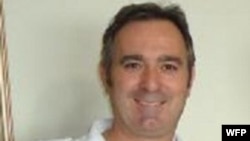After almost three months in captivity, British aid worker Patrick Noonan is going home.
“He’s very much looking forward to seeing his two daughters,” says Bettina Luescher, a World Food Program spokesperson. “We’re glad that this story is over.”
Noonan was working for the World Food Program’s logistic team in the Sudan’s Darfur area when armed men seized him and his Sudanese driver last March. The attackers released the driver a few hours later, but they held Noonan for 86 days.
Luescher says the World Food Program cannot say where Noonan was during that time, or how UN, Sudanese, and UK officials negotiated his release.
“He’s apparently in good health, happy to be out, and we’re just glad that he’s free again,” says Luescher. “For an aid organization, those are always troubling times. We were very, very concerned about his well-being, we’re glad, we’re grateful to everyone who helped free him.”
Abby Stoddard, a researcher with a group called Humanitarian Outcomes that advises governments and NGOs, explains that aid workers are protected by international law. However, host governments are ultimately responsible for keeping aid workers safe. That may be a reason why South Sudan has joined Afghanistan, Pakistan, Somalia, and Sudan as some of the most dangerous places for aid workers
“Similar to Sudan itself, it’s a country where the government has not been able to extend a security presence and law and order to a vast expanse of territory, and where both militants and regular criminals can act with impunity,” says Stoddard.
When you get down to it, Stoddard says, aid organizations end up providing their own protection—but most try to avoid using armed guards and walled-off compounds.
“Many rely instead on what’s been called the acceptance approach to security, which is about actively communicating and negotiating with all local actors and parties to the conflict and trying to gain their acceptance and support--and by extension a measure of protection.”
When something does go wrong, as it did with Patrick Noonan, the World Food Program and other aid organizations say they do not pay ransom.
“It’s one of the policies we have,” Luescher explains. “If we did that, then aid workers all over the world would be more in danger.”
That danger can be seen in Somalia, for example. Recently militants there killed two World Food Program workers in two months and effectively kicked the World Food Program out of a country that desperately needed its help.
Luescher says the danger aid workers face is one of the reasons they are real heroes.
“Not only do they leave their families behind, but they also risk their lives. All to make sure that a little child or a young mother gets a little bit of food or a little bit of shelter and some safety.”
That risk goes on every day for aid workers along the border between Sudan and South Sudan.







